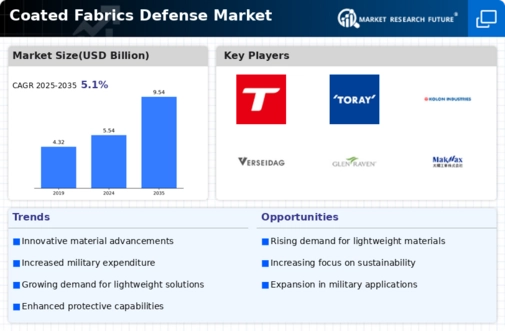Market Growth Projections
The Global Coated Fabrics Defense Market Industry is projected to experience substantial growth over the next decade. With an estimated market value of 5.54 USD Billion in 2024, it is anticipated to reach 9.54 USD Billion by 2035. This growth trajectory suggests a compound annual growth rate of 5.07% from 2025 to 2035. Such projections indicate a robust demand for coated fabrics in defense applications, driven by factors such as rising defense budgets, technological advancements, and the increasing focus on lightweight and sustainable materials. The market's expansion reflects the evolving needs of defense forces worldwide.
Rising Defense Expenditure
The Global Coated Fabrics Defense Market Industry experiences a notable increase in defense budgets across various nations. In 2024, global military spending is projected to reach approximately 5.54 USD Billion, reflecting a growing emphasis on advanced materials for military applications. This trend is driven by the need for enhanced protection and durability in defense gear, which coated fabrics provide. Countries are investing in innovative technologies to improve the performance of their defense equipment, thereby boosting demand for coated fabrics. As military expenditure continues to rise, the Global Coated Fabrics Defense Market Industry is likely to expand significantly, catering to the evolving requirements of armed forces.
Technological Advancements
Technological innovations play a crucial role in shaping the Global Coated Fabrics Defense Market Industry. The development of advanced coating techniques enhances the performance characteristics of fabrics, such as water resistance, flame retardancy, and durability. These advancements enable manufacturers to produce high-quality coated fabrics that meet stringent military standards. For instance, the integration of nanotechnology in fabric coatings has shown promising results in improving the protective capabilities of defense gear. As these technologies evolve, they are expected to drive growth in the Global Coated Fabrics Defense Market Industry, with an anticipated compound annual growth rate of 5.07% from 2025 to 2035.
Growing Focus on Sustainability
Sustainability is becoming an integral aspect of the Global Coated Fabrics Defense Market Industry. With increasing awareness of environmental issues, defense manufacturers are seeking eco-friendly coated fabrics that minimize environmental impact. This shift is prompting the development of sustainable materials and production processes, aligning with global sustainability goals. Governments are also encouraging the use of sustainable practices in defense procurement, further driving demand for eco-friendly coated fabrics. As the industry adapts to these changes, the Global Coated Fabrics Defense Market Industry is likely to see a rise in the adoption of sustainable materials, reflecting a broader commitment to environmental responsibility.
Emerging Markets and Geopolitical Tensions
The Global Coated Fabrics Defense Market Industry is significantly influenced by geopolitical tensions and the emergence of new markets. Countries facing security challenges are increasingly investing in defense capabilities, leading to a heightened demand for coated fabrics. Emerging markets, particularly in Asia-Pacific and the Middle East, are expanding their defense sectors, creating opportunities for coated fabric manufacturers. As nations prioritize national security and defense readiness, the Global Coated Fabrics Defense Market Industry is expected to benefit from this trend, with increased orders for coated fabrics from both established and emerging defense markets.
Increased Demand for Lightweight Materials
The Global Coated Fabrics Defense Market Industry is witnessing a shift towards lightweight materials that do not compromise on strength or durability. This trend is largely influenced by the need for enhanced mobility and comfort for military personnel. Lightweight coated fabrics are increasingly being utilized in the production of uniforms, tents, and other defense equipment. As armed forces prioritize agility and efficiency, the demand for these materials is expected to rise. The market is projected to grow from 5.54 USD Billion in 2024 to 9.54 USD Billion by 2035, indicating a robust expansion driven by the adoption of lightweight solutions in defense applications.
























Leave a Comment